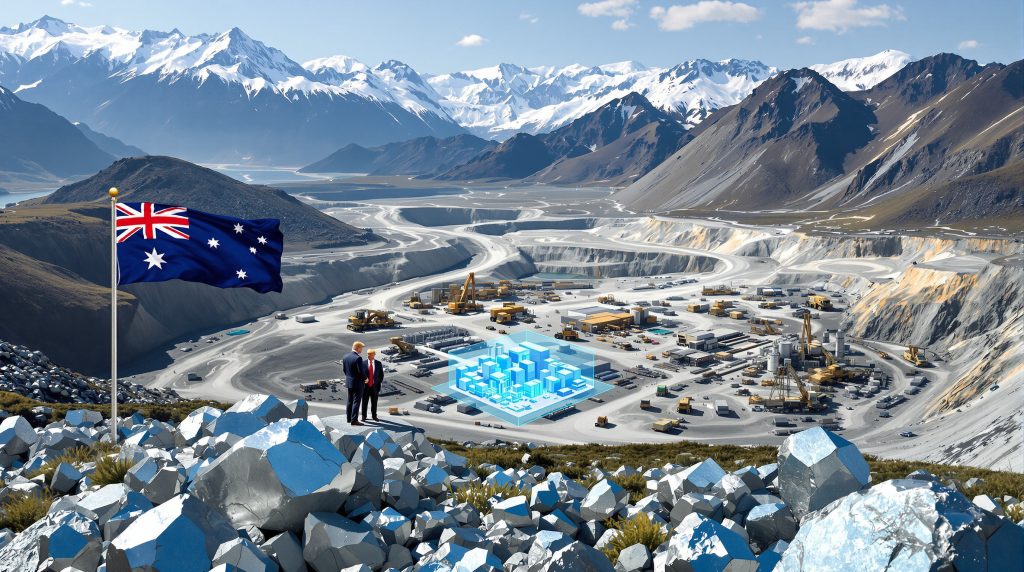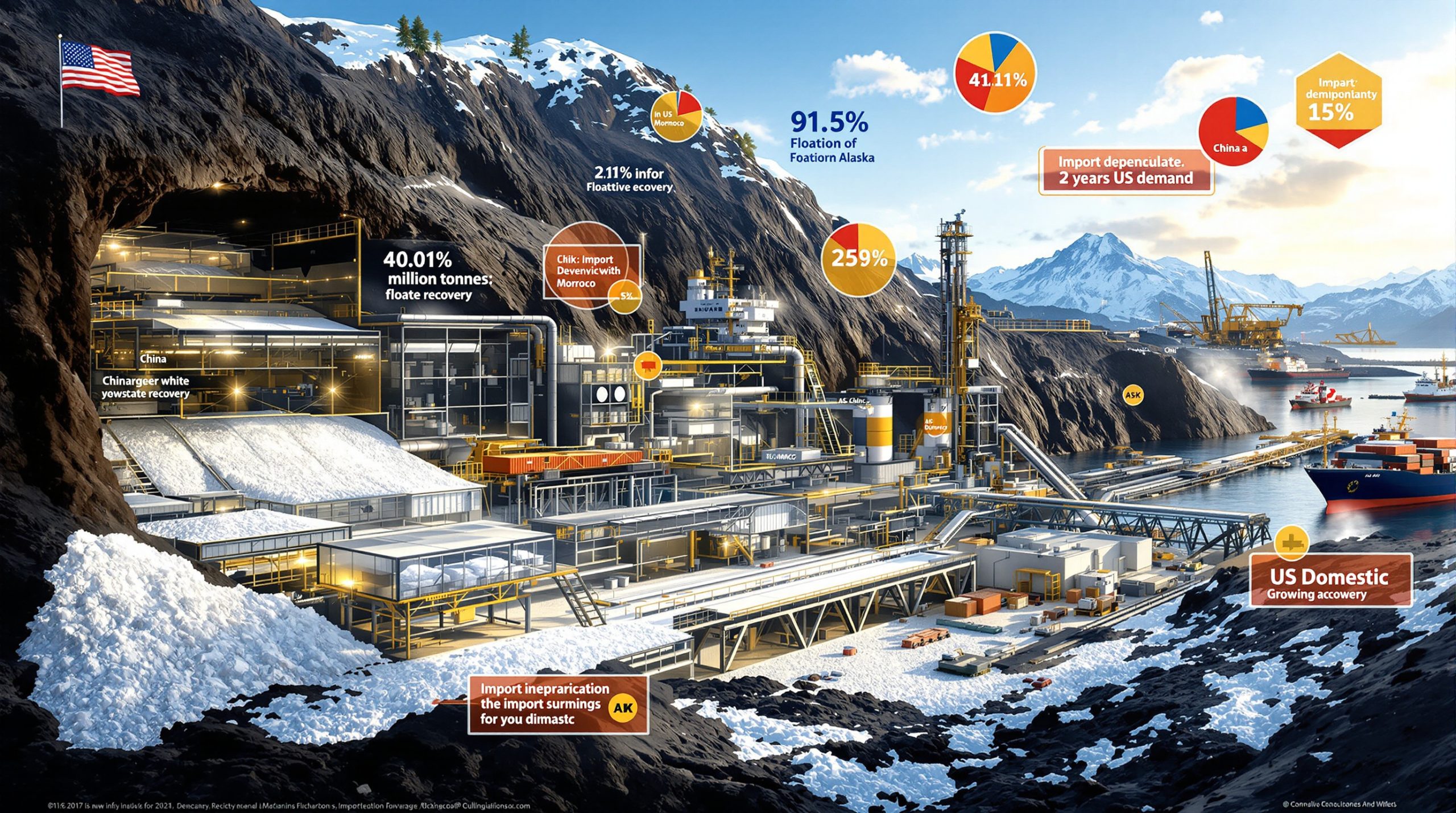Nova Minerals Critical Minerals Briefing: Strategic Significance for Australia-U.S. Relations
Nova Minerals (ASX: NVA) has emerged as a pivotal player in the critical minerals sector, with its Estelle Gold and Critical Minerals Project in Alaska gaining unprecedented attention from high-level government officials. The project's strategic importance stems from its dual potential for gold production and antimony extraction—the latter being classified as a critical mineral essential for defense applications, energy storage systems, and various industrial uses.
With a recent 80% share price surge following diplomatic interest, Nova Minerals is positioning itself at the intersection of geopolitics and resource security, offering investors exposure to both gold prices analysis and strategically vital minerals markets.
The Estelle Project: A Dual-Resource Powerhouse
The Estelle Project spans 514 square kilometers within Alaska's resource-rich Tintina Gold Belt. While primarily known for its substantial gold resources (9.9 million ounces JORC-compliant), the project's antimony potential has become increasingly significant in light of global supply chain concerns.
Located in a stable jurisdiction with supportive regulatory frameworks, the Estelle Project benefits from Alaska's established mining infrastructure and proximity to deepwater shipping facilities at Port MacKenzie. This accessibility represents a significant advantage over many competing antimony projects located in more challenging jurisdictions.
The project's dual-resource profile provides Nova Minerals with strategic flexibility, allowing the company to balance development priorities between gold and antimony based on market conditions, funding opportunities, and geopolitical considerations.
Antimony: The Critical Mineral Driving Strategic Interest
Antimony's classification as a critical mineral by both U.S. and Australian governments has elevated its importance in national security discussions. This metalloid is essential for:
- Military applications including ammunition, armor plating, and night-vision technology
- Flame retardants for electronics, textiles, and building materials
- Battery technologies, particularly emerging liquid metal batteries
- Semiconductor manufacturing and various electronic components
According to the U.S. Geological Survey, over 80% of global antimony supply is controlled by China, Russia, and Tajikistan, creating significant supply vulnerability for Western nations. This concentration of supply has pushed antimony onto priority lists for mineral security initiatives in both the United States and Australia.
With global antimony consumption growing at approximately 3% annually and strategic stockpiles declining, new Western-controlled sources have become critical to national security planning across allied nations.
How Did Nova Minerals Capture High-Level Government Attention?
The Diplomatic Breakthrough
In a remarkable development, Australian Ambassador to the United States Kevin Rudd personally requested a briefing from Nova Minerals regarding its Estelle Project. This request came in preparation for high-level discussions between Prime Minister Anthony Albanese and President Donald Trump, scheduled for October 2025 in Washington, D.C.
This level of diplomatic engagement is exceptionally rare for a junior mining company, signaling the strategic importance attached to the Estelle Project's antimony potential. The briefing request reflects growing recognition of critical minerals energy transition as a cornerstone issue in Australia-U.S. relations, particularly as both nations work to reduce dependence on potentially hostile suppliers.
The company's ability to attract this level of attention reflects both the strategic significance of antimony and the growing alignment between Nova's development timeline and national security priorities in both countries.
Market Reaction to the Diplomatic Interest
The market's response to this diplomatic attention was immediate and dramatic:
- Nova's share price surged approximately 80% in a single trading session following the announcement
- Trading volumes reached unprecedented levels, with several times the average daily volume changing hands
- The company's market capitalization expanded significantly, reflecting investor recognition of the potential strategic partnership value
This market reaction highlights the growing premium investors are placing on critical minerals projects with clear government support and strategic significance. While commodity fundamentals remain important, the diplomatic attention has added a national security premium to Nova's valuation.
Strategic Timing in Global Minerals Politics
This high-level interest coincides with growing concerns about critical minerals supply chains, particularly those dominated by China. Both Australia and the United States have been actively developing strategies to secure alternative supply sources for materials deemed essential to national security and economic prosperity.
The timing is particularly significant given recent developments:
- China implemented export restrictions on antimony in late 2024, citing national security concerns
- Defense contractors have reported supply disruptions for antimony compounds used in military applications
- The U.S. National Defense Stockpile of antimony has declined to historically low levels
- Australia's defense minerals strategy specifically identified antimony as a priority element for development
What Government Support Has Nova Minerals Already Secured?
U.S. Department of Defense Funding
Nova Minerals' strategic positioning has already yielded tangible benefits, most notably a A$43 million award from the U.S. Department of Defense to its subsidiary, Alaska Range Resources. This substantial funding package aims to:
- Accelerate the development of antimony production capabilities
- Support the creation of a fully integrated antimony supply chain
- Enable military-grade antimony output targeted for 2026-2027
This funding represents one of the largest Defense Production Act Title III investments in critical minerals development outside of rare earth elements, underscoring the strategic importance assigned to antimony by defense planners.
The Department of Defense support extends beyond financial backing to include technical assistance, regulatory coordination, and potential offtake arrangements for military-grade antimony products. This multi-faceted support package significantly de-risks the project's development pathway.
Infrastructure Development Progress
The company has made significant progress on the infrastructure front, securing a land use permit for an antimony refinery at Port MacKenzie, Alaska. This facility represents a critical component in Nova's strategy to become a vertically integrated producer of antimony products for both military and industrial applications.
Port MacKenzie offers several strategic advantages:
- Deep-water access for shipping finished products to domestic and international markets
- Rail connection to the Alaska Railroad system
- Proximity to skilled workforce in the Anchorage metropolitan area
- Established utilities including power, water, and natural gas
The permitting milestone demonstrates Nova's ability to navigate Alaska's regulatory framework efficiently, an important consideration for investors assessing project development risk.
What Challenges Does Nova Minerals Face in Project Development?
Capital Requirements for Full-Scale Development
Despite the promising government support and strategic antimony financing, Nova Minerals faces substantial financial challenges:
- The full development of the Estelle Project is estimated to require A$200-300 million in additional capital
- This funding requirement may necessitate equity dilution, strategic partnerships, or additional government support
- Balancing the dual development paths for gold and antimony resources adds complexity to capital allocation decisions
While the A$43 million Department of Defense funding provides significant runway, the company will need to develop a comprehensive funding strategy that maintains shareholder value while advancing both the gold and antimony aspects of the project.
Technical and Operational Hurdles
Developing a major mining operation in Alaska presents various technical and operational challenges:
- Harsh climate conditions limiting the operational season to approximately 7-8 months annually
- Complex logistics for equipment and supplies in a relatively remote location
- Environmental permitting requirements in a sensitive ecosystem
- Skilled workforce recruitment and retention in a challenging labor market
Alaska's mining industry has successfully addressed these challenges at other operations, but they represent real considerations in Nova's development timeline and operational planning. The company's ability to navigate these challenges efficiently will be critical to maintaining its first-mover advantage in Western antimony production.
Timeline to Production
While Nova has secured significant support and funding, the path to full-scale production involves multiple stages:
| Development Stage | Estimated Timeline | Key Milestones |
|---|---|---|
| Exploration & Resource Definition | Ongoing | Maiden antimony resource estimate expected in 2025 |
| Pre-Feasibility Study | 2025-2026 | Engineering designs, preliminary economics |
| Permitting | 2025-2027 | Environmental approvals, operating licenses |
| Construction | 2026-2028 | Mine development, processing facilities |
| Initial Production | 2027-2028 | First antimony and gold output |
| Full-Scale Operations | 2028+ | Ramp-up to target production levels |
This timeline aligns with government strategic planning horizons but requires disciplined execution to maintain momentum. The company's ability to achieve these milestones on schedule will be closely watched by both investors and government stakeholders.
How Does Nova Minerals Fit into the Global Critical Minerals Landscape?
Geopolitical Significance of the Estelle Project
The Estelle Project's location in Alaska provides several strategic advantages in the current geopolitical climate:
- Located within a stable, allied nation with strong rule of law
- Positioned to supply both U.S. and Australian markets
- Potential cornerstone of Western supply chain diversification efforts
- Aligned with both nations' critical minerals strategies
These advantages are particularly significant given the increasing emphasis on "friend-shoring" of critical supply chains—the practice of shifting production and sourcing to politically allied nations rather than potential adversaries.
Comparison to Global Antimony Supply
Nova's potential antimony production would represent a significant shift in global supply dynamics:
- Currently, China controls approximately 60% of global antimony production
- Russia and Tajikistan account for most of the remaining supply
- The Estelle Project is positioned to become a leading Western source
- North American antimony processing capacity is extremely limited, creating a bottleneck that Nova's integrated approach addresses
This supply context explains the strategic interest in Nova's development timeline and the willingness of the U.S. government to provide significant financial support.
Integration with Broader Critical Minerals Initiatives
Nova's development aligns with several government initiatives:
- Australia's Critical Minerals Strategy, which identifies antimony as a priority element
- U.S. Defense Production Act investments in critical minerals
- Bilateral critical minerals cooperation agreements between Australia and the United States
- Potential inclusion in mineral security partnerships like the Quad Critical and Emerging Technology Working Group
This alignment positions Nova to benefit from continued policy support and potential additional funding as these initiatives expand. Additionally, the company stands to gain significantly from Trump's critical minerals order which prioritizes domestic production.
What Does This Mean for Investors?
Investment Thesis for Nova Minerals
The investment case for Nova Minerals rests on several pillars:
- Dual exposure to gold and critical minerals markets
- Strategic government relationships and funding support
- First-mover advantage in Western antimony production
- Potential for premium valuation due to national security applications
This combination offers investors exposure to both traditional precious metals markets and the emerging strategic minerals sector, potentially providing portfolio diversification benefits alongside growth potential.
Risk Factors to Consider
Potential investors should weigh several risk factors:
- Execution risk in developing a complex, remote project
- Potential for equity dilution to fund development
- Commodity price volatility for both gold and antimony
- Changing political priorities affecting government support
- Competition from other emerging antimony projects globally
While government support provides significant de-risking, these factors remain important considerations in investment decision-making.
Comparable Companies and Valuation Metrics
To contextualize Nova's position, investors might consider these comparable companies:
- Junior gold developers with similar-sized resources
- Critical minerals companies with strategic government partnerships
- Mining companies with dual commodity exposure
- Alaska-focused resource developers
Relative valuation metrics such as enterprise value per resource ounce and price-to-NAV ratios provide helpful benchmarking tools, while recognizing that Nova's strategic positioning may justify premium valuations compared to pure commodity exposure.
What's Next for Nova Minerals and the Critical Minerals Sector?
Near-Term Catalysts for Nova Minerals
Several potential catalysts could drive Nova's development in the coming months:
- Results from the high-level Australia-U.S. discussions
- Publication of a maiden antimony resource estimate
- Additional government funding announcements
- Strategic partnership developments
- Advancement of pre-feasibility studies
These catalysts provide multiple potential inflection points for value creation, offering investors various opportunities for reassessment of Nova's strategic position.
Broader Sector Trends to Watch
The critical minerals sector is likely to be shaped by several emerging trends:
- Increasing government intervention in supply chains
- Growing investment in processing and refining capacity
- Development of strategic stockpiles and reserves
- Formation of "mineral security alliances" among like-minded nations
- Integration of critical minerals considerations into trade agreements
According to recent analysis by MetalTech News, Nova's positioning at the intersection of these trends suggests potential for continued policy support and strategic interest.
Long-Term Strategic Positioning
Nova Minerals' long-term strategy appears focused on:
- Becoming a cornerstone of Western antimony supply
- Developing a fully integrated mine-to-market operation
- Leveraging government relationships to secure preferential market access
- Potentially expanding into other critical minerals present at the Estelle Project
This strategic vision aligns with broader geopolitical trends and suggests potential for Nova to evolve beyond its current project focus into a more diversified critical minerals producer. As Proactive Investors reports, the company's ambitious timeline targets antimony production by 2026-27.
FAQ: Nova Minerals and Critical Minerals
Why is antimony classified as a critical mineral?
Antimony is designated as a critical mineral due to its essential applications in defense, energy storage, and electronics, combined with highly concentrated global supply chains dominated by China and Russia. This supply concentration creates vulnerability for Western nations that rely on antimony for military and industrial applications.
The U.S. Geological Survey identifies antimony as having both high importance to economic and national security and high supply risk, placing it among the most critical minerals in their assessment framework.
How does the Estelle Project compare to other antimony sources globally?
The Estelle Project is distinguished by its location in a stable jurisdiction (Alaska), its dual gold-antimony potential, and its advanced stage of development with significant government backing. While global antimony resources exist in various countries, few projects combine these advantages with near-term production potential.
Most competing projects face challenges related to political instability, lower grades, or limited infrastructure access that complicate their development pathways.
What role might government play in Nova Minerals' development?
Governments may continue to support Nova Minerals through direct funding, offtake agreements, expedited permitting, infrastructure development, and potential inclusion in strategic minerals initiatives. The high-level diplomatic interest suggests the project may become a focal point for U.S.-Australia critical minerals cooperation.
This support could extend to investment incentives, tax benefits, and preference in government procurement programs for domestically-produced antimony products.
How might geopolitical tensions affect Nova Minerals' prospects?
Escalating tensions between Western nations and China could accelerate efforts to develop alternative antimony supplies, potentially benefiting Nova Minerals. However, these same tensions could also disrupt global supply chains, affecting equipment availability and project development timelines.
The overall balance of these effects is likely to be positive for Nova, as supply security concerns typically outweigh short-term development challenges in strategic government planning.
What timeline should investors expect for Nova Minerals to achieve production?
While initial antimony production is targeted for 2026-2027, full-scale integrated operations may take until 2028 or beyond to achieve. The development timeline will depend on permitting processes, funding availability, and technical progress in resource definition and engineering studies.
This timeline aligns with critical minerals strategies in both Australia and the United States, which typically focus on 3-5 year development horizons for priority materials.
Further Exploration
Readers interested in learning more about critical minerals and their strategic importance can explore related educational resources about the Australian resources sector and critical minerals developments. Understanding the intersection of geopolitics, resource security, and mining development will be increasingly valuable as these themes continue to shape global markets.
With antimony and other critical minerals likely to remain focal points for government policy and investment, the evolving landscape presents both opportunities and challenges for resource investors seeking exposure to this strategically important sector.
Ready to Spot the Next Major Mineral Discovery?
Stay ahead of the market with Discovery Alert's proprietary Discovery IQ model, providing instant notifications when significant ASX mineral discoveries are announced. Explore how historic discoveries have generated substantial returns by visiting our dedicated discoveries page.




